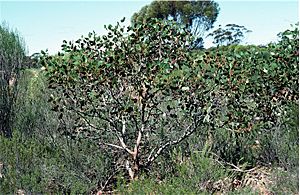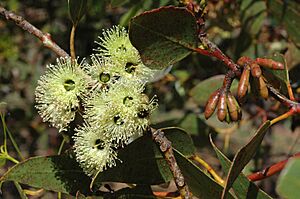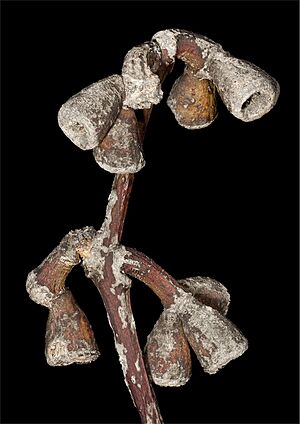Coarse-leaved mallee facts for kids
Quick facts for kids Coarse-leaved mallee |
|
|---|---|
 |
|
| Eucalyptus grossa near Balladonia | |
| Scientific classification | |
| Genus: |
Eucalyptus
|
| Species: |
grossa
|
| Synonyms | |
|
Eucalyptus incrassata var. grossa (F.Muell. ex Benth.) Maiden |
|
The Eucalyptus grossa, often called the coarse-leaved mallee, is a special type of mallee tree or shrub. It grows only in Western Australia. This plant has rough, stringy bark on its trunk and main branches. Its adult leaves are shaped like eggs or wide spearheads. It has flower buds that grow in groups of seven, yellowish-green flowers, and fruit shaped like cups or cylinders.
What it Looks Like
Eucalyptus grossa is usually a mallee, which means it's a shrubby tree with many stems growing from the ground. It can also be a small, straggly tree or even just a shrub. It usually grows between 0.5 and 5 meters (about 1.5 to 16 feet) tall. This plant has a special woody swelling at its base called a lignotuber. This helps it regrow after fires.
The bark on its trunk and branches is rough and fibrous. It can be grey or brownish. Young plants have leaves that are somewhat egg-shaped. These leaves are about 45 to 80 millimeters (1.8 to 3.1 inches) long and 30 to 55 millimeters (1.2 to 2.2 inches) wide.
Adult leaves are shiny green and can be egg-shaped or broadly spear-shaped. They are usually 75 to 125 millimeters (3 to 5 inches) long and 25 to 55 millimeters (1 to 2.2 inches) wide. These leaves have a stalk called a petiole, which is 15 to 45 millimeters (0.6 to 1.8 inches) long.
The flower buds grow in groups of seven. They are found where the leaf meets the stem. These buds are on a thick, downward-pointing stalk called a peduncle, which is 10 to 35 millimeters (0.4 to 1.4 inches) long. Each bud is either directly attached or has a very short, thick stalk (up to 2 millimeters long).
Mature buds are quite large, about 18 to 32 millimeters (0.7 to 1.3 inches) long and 7 to 13 millimeters (0.3 to 0.5 inches) wide. They have a cone-shaped cap called an operculum. The flowers are yellowish-green and bloom mostly from August to November.
After flowering, the plant produces woody, cylindrical fruits. These fruits are called capsules. They are about 14 to 20 millimeters (0.6 to 0.8 inches) long and 10 to 15 millimeters (0.4 to 0.6 inches) wide. The parts that open to release seeds are usually at or below the rim of the fruit.
How it was Named
The Eucalyptus grossa was first officially described in 1867. This was done by a botanist named George Bentham. He used notes from an earlier, unpublished description by Ferdinand von Mueller. The first samples of this plant were collected by George Maxwell near the Phillips River in Western Australia.
The scientific name grossa comes from a Latin word, grossus. This word means 'thick' or 'coarse'. This name refers to the plant's thick leaves, buds, and fruit.
Where it Grows
The coarse-leaved mallee grows in specific areas of Western Australia. You can find it near granite rocks and in dense groups of plants called thickets. It grows on flat or gently rolling land. Its range stretches from near Newdegate to the south and east of Norseman. These areas are part of the Coolgardie, Esperance Plains, and Mallee regions.
Conservation Status
The Western Australian Government's Department of Parks and Wildlife has classified this eucalypt as "not threatened." This means it is not currently at risk of disappearing.
Uses in Gardens
This species is popular for planting in gardens because of its attractive flowers. If you prune it regularly, you can keep it as a dense, compact shrub. It has shown that it can adapt well to many different growing conditions in temperate parts of Australia.



